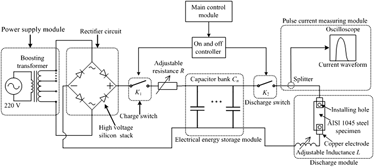Article contents
Application of high-energy oscillating electric current pulse to relieve pulsed-laser surface irradiation induced residual stress in AISI 1045 steel
Published online by Cambridge University Press: 03 November 2016
Abstract

The high-energy oscillating electric current pulse (ECP) technology was introduced to relieve the residual stresses in the small AISI 1045 steel specimens treated by the pulsed-laser surface irradiation. The high-energy oscillating ECP stress relief experiments were conducted to study the effectiveness of the high-energy oscillating ECP technology. In addition, the electroplasticity framework was developed based on the thermal activation theory to reveal the mechanism of the high-energy oscillating ECP stress relief. The results show that the high-energy oscillating ECP stress relief has good effects on eliminating the residual stress. Furthermore, the residual stress relieving mechanism of the high-energy oscillating ECP stress relief can be attributed to the electric softening effect and the dynamic stress effect. The findings confirm that the significant effects of high-energy oscillating ECP on metal plasticity and provide a basis to understand the underlying mechanism of the high-energy oscillating ECP stress relief.
Keywords
- Type
- Articles
- Information
- Copyright
- Copyright © Materials Research Society 2016
References
REFERENCES
- 3
- Cited by





